
|
Philippines, 21 Dec 2025 |
Home >> News |
 |
||||
|
|
|
|
PIONEERING FILIPINO BOXERS TAKE THE SPOTLIGHT ON FIL-AM HISTORY MONTH (PART II) By Dong Secuya PhilBoxing.com Fri, 17 Oct 2025 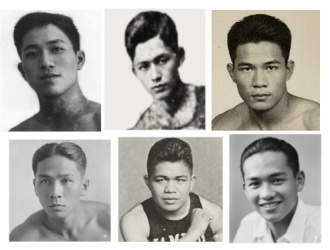 Long before the legendary names of Manny Pacquiao, Luisito Espinosa, Flash Elorde, and even Pancho Villa captured the imagination of boxing fans worldwide, a generation of forgotten Filipino pugilists had already blazed the trail for them to follow. More than a century later, their names might have been lost forever—had one man not dug their stories out from the bowels of brittle news clippings, yellowed photographs, and worn-out memorabilia. The boxing route established between the Philippines and the United States in the early 1900s quickly gave rise to a flood of Filipino fighters. Yet, for the first three decades, most of these trailblazers—often exploited and fighting merely to survive—were largely erased from public memory, their stories buried deep in old newspaper stacks. Top photo (clockwise): Eddie Duarte, Paul Gyn, Francisco Labra, Cowboy Reyes, Silvino Jamito and Diosdado Posadas. 
The celebrated Pancho Villa (Francisco Guilledo) graces the Ring Magazine cover on its January, 2023 issue. Only a few achieved the kind of fame that could secure them a permanent place in history: • Francisco “Pancho” Villa (Francisco Guilledo) – World Flyweight Champion, 1923, and the first Asian to win a world title. • Ceferino Garcia – World Middleweight Champion, 1939, known for inventing the “bolo punch.” • Benjamin “Small Montana” Gan and Eleuterio “Little Dado” Zapanta – beloved for their exciting styles and championship-level skill. 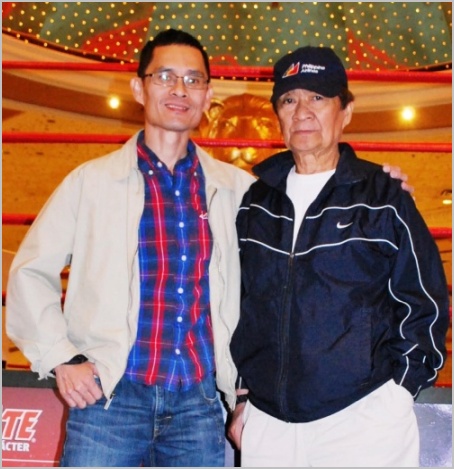
Emmanuel Rivera (L) poses with his late father Hermie Rivera. The Detective of Filipino Boxing History The task of resurrecting the stories of these overlooked fighters has fallen to Emmanuel Rivera affectionately called Noel by his friends and relatives. Noel is a respiratory therapist in the Bay Area and the son of the late Hermie Rivera, one of the Philippines’ most respected sports journalists. Inspired by his father’s lifelong devotion to boxing, Noel began an extraordinary mission—to rediscover the earliest Filipino boxers and reclaim their rightful place in history. With the persistence of a professional sleuth, Rivera spent countless hours poring over old books and vintage newspaper clippings meticulously preserved at the San Francisco Public Library (SFPL). He soon became a familiar figure there, forging friendships with librarians and attendants who shared his enthusiasm. Rivera also drew inspiration and guidance from his father’s friend, Jack Fiske, the late American boxing writer whose vast collection of memorabilia included items related to Filipino fighters. In 2020, Rivera founded the Philippine Boxing Historical Society (PBHS)—a living archive devoted to documenting the pioneers of Filipino boxing. Its growing collection now includes rare photographs, gloves, fight posters, and original news articles—the most comprehensive record yet of Filipino pugilists from the early 1900s. 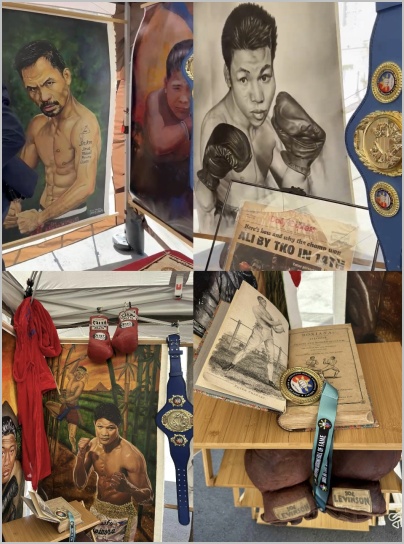
A few of the boxing mementos on exhibit at the PBHS booth. Unveiling the First Professionals Rivera’s ongoing research—soon to be published in book form—has unearthed details never before known to modern readers, altering the accepted narrative of Philippine boxing history. Among his most remarkable discoveries is Eustaquio “Eddie” Duarte, whom Rivera identifies as the first professional Filipino boxer, active around 1910. According to Rivera’s findings, the young Duarte joined the U.S. Army Transport Ship USAT Burnside in 1899, when it was docked in Cebu City taking on coal. Stowing away from his hometown of Paypay, Daan Bantayan, Duarte became part of the ship’s crew—a decision that would forever change his life. 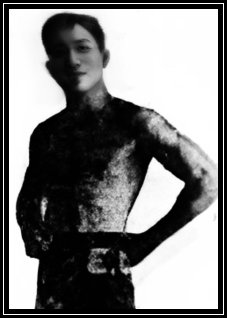
Eustaquio "Eddie" Duarte, the first Filipino pro boxer. From Rivera’s article Eustaquio Duarte: The First Professional Boxer from the Philippines: Onboard, Duarte discovered a new passion—the manly art of boxing. When duties allowed, sailors would stage friendly bouts, and Duarte quickly proved himself a formidable opponent despite his youth and stature. His skill and determination endeared him to the officers, earning their respect and admiration. While his ship was docked in Tacoma, Washington, Duarte refined his craft, joining both sanctioned and underground fights representing his fellow sailors. He soon became a sensation on the West Coast, packing arenas such as San Francisco’s Dreamland Rink. The crowd had never seen a fighter from the Philippines before, and Duarte was introduced to them as ‘Filipino Duarte.’ Under promoter Stewart Alfred Tait and matchmaker Joseph Hyman Waterman, Duarte was rebranded as Eddie Duarte and returned to Manila a celebrated fighter. With his strength, courage, and unshakable resolve, he became the first Filipino professional boxer to make his mark both abroad and at home. In 2024, this writer contacted Duarte’s surviving relatives in Paypay, Daan Bantayan, Cebu, who confirmed key details of the old fighter’s story—lending living testimony to Rivera’s discovery. Rivera’s research has also resurrected other long-forgotten names that once lit up early American rings: Paul Gyn (1913–1918), Francisco Labra (1913–1925), Cowboy Reyes (1913–1927), and Silvino Jamito (1913–1928), hailed as the first Filipino international boxing star. Others include Pablo Dano, Diosdado Posadas, Lope Tenorio, Macario Villion, and many more whose lives and fights are now finally being retold. A Family Affair Every exhibit takes many hands to assemble. At the Fulton Plaza booth of the Philippine Boxing Historical Society during Bangon Kabayan: Pistahan sa Fulton, Noel Rivera was joined by his son Grant, his sister Charina, and Charina’s daughter Keanna. Together, they honored their patriarch, Hermie Rivera, one of the pillars of Philippine sports journalism, whose legacy continues through their shared dedication to preserving the nation’s boxing heritage. 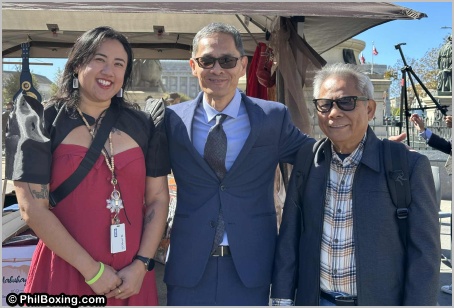
L-R: SFPL's Jaena Rae Cabrera, Noel Rivera and the author. 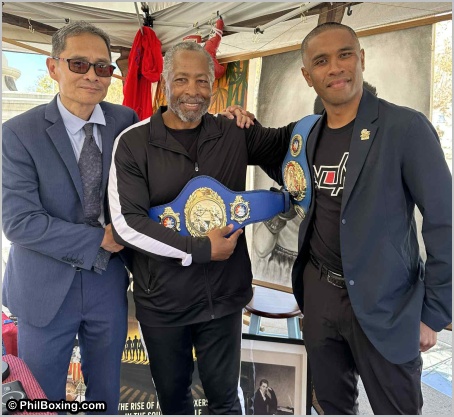
L-R: Rivera, Martial Artists Danovis “Dee” Pooler, and Kru Mark Tabuso. It is fitting that this Filipino American History Month cultural celebration was held at Fulton Plaza, in San Francisco’s Civic Center, where the Pioneer Monument stands. The monument, dedicated to California’s earliest settlers, now symbolically honors the spirit of those first Filipino sailors—and, by extension, the pioneering Filipino boxers who followed them across the Pacific. They were the first wave of Filipino-American sportsmen, men who fought not only for victory inside the ring, but for recognition, dignity, and a place in a new world. 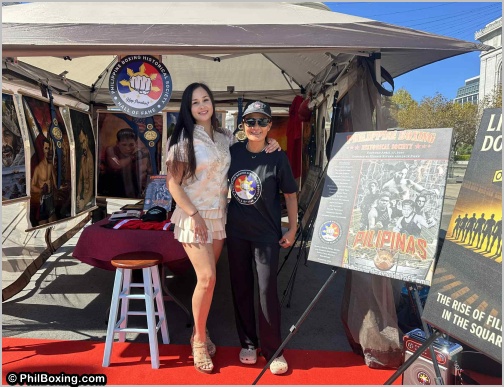
Rivera's sister Charina (R) and Charina's daughter Keana (L). 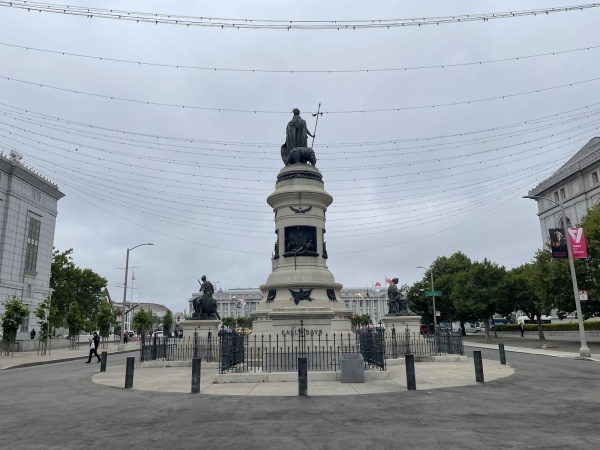
San Francisco Pioneer Monument at the Fulton Plaza. Click here for Part I. Click here to view a list of other articles written by Dong Secuya. |
|
|
PhilBoxing.com has been created to support every aspiring Filipino boxer and the Philippine boxing scene in general. Please send comments to feedback@philboxing.com |
PRIVATE POLICY | LEGAL DISCLAIMER
developed and maintained by dong secuya © 2025 philboxing.com. |